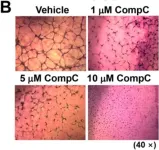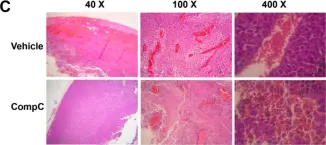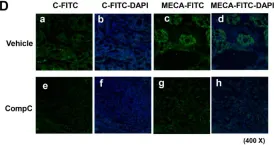The function of fibroblasts in intracerebral hemorrhage (ICH) remains elusive. By targeting Col1α1, a fibroblast-specific marker, we generate mice with ablated Col1α1+ fibroblasts. These mutants show exacerbated blood-brain barrier (BBB) damage, enlarged injury volume, and worse neurological function, highlighting a beneficial role of Col1α1+ fibroblasts in ICH. Echoing these findings, fibroblasts significantly decrease endothelial permeability in an in vitro ICH model. Next, we demonstrate that fibroblasts promote BBB integrity in ICH mainly via up-regulating tight junction proteins without affecting transcytosis-associated proteins, indicating a paracellular rather than transcellular mechanism. A subsequent mechanistic study reveals that the BBB-protective effect of fibroblasts is partially mediated by TIMP metallopeptidase inhibitor 2 (TIMP2). Furthermore, we find that exogenous TIMP2 attenuates BBB disruption in these mutants after ICH. These results suggest that Col1α1+ fibroblasts repair BBB damage in ICH via the paracellular pathway in a TIMP2-dependent manner, and that Col1α1+ fibroblasts and TIMP2 may be targeted in ICH treatment.
Copyright © 2022 The Author(s). Published by Elsevier Inc. All rights reserved.
Product Citations: 18
Fibroblasts repair blood-brain barrier damage and hemorrhagic brain injury via TIMP2.
In Cell Reports on 22 November 2022 by Xu, L., Nirwane, A., et al.
-
Cardiovascular biology
In Transplantation and Cellular Therapy on 1 August 2022 by Héja, D., Zhao, D., et al.
Conditioning regimens used for hematopoietic stem cell transplantation (HCT) can escalate the severity of acute T cell-mediated graft-versus-host disease (GVHD) by disrupting gastrointestinal integrity and initiating lipopolysaccharide (LPS)-dependent innate immune cell activation. Activation of the complement cascade has been associated with murine GVHD, and previous work has shown that alternative pathway complement activation can amplify T cell immunity. Whether and how mannan-binding lectin (MBL), a component of the complement system that binds mannose as well as oligosaccharide components of LPS and lipoteichoic acid, affects GVHD is unknown. In this study, we tested the hypothesis that MBL modulates murine GVHD and examined the mechanisms by which it does so. We adoptively transferred C3.SW bone marrow (BM) cells ± T cells into irradiated wild type (WT) or MBL-deficient C57Bl/6 (B6) recipients with or without inhibiting MBL-initiated complement activation using C1-esterase inhibitor (C1-INH). We analyzed the clinical severity of disease expression and analyzed intestinal gene and cell infiltration. In vitro studies assessed MBL expression on antigen-presenting cells (APCs) and compared LPS-induced responses of WT and MBL-deficient APCs. MBL-deficient recipients of donor BM ± T cells exhibited significantly less weight loss over the first 2 weeks post-transplantation weeks compared with B6 controls (P < .05), with similar donor engraftment in the 2 groups. In recipients of C3.SW BM + T cells, the clinical expression of GVHD was less severe (P < .05) and overall survival was better (P < .05) in MBL-deficient mice compared with WT mice. On day-7 post-transplantation, analyses showed that the MBL-deficient recipients exhibited less intestinal IL1b, IL17, and IL12 p40 gene expression (P < .05 for each) and fewer infiltrating intestinal CD11c+, CD11b+, and F4/80+ cells and TCRβ+, CD4+, CD4+IL17+, and CD8+ T cells (P < .05 for each). Ovalbumin or allogeneic cell immunizations induced equivalent T cell responses in MBL-deficient and WT mice, demonstrating that MBL-deficiency does not directly impact T cell immunity in the absence of irradiation conditioning. Administration of C1-INH did not alter the clinical expression of GVHD in preconditioned WT B6 recipients, suggesting that MBL amplifies clinical expression of GVHD via a complement-independent mechanism. WT, but not MBL-deficient, APCs express MBL on their surfaces. LPS-stimulated APCs from MBL-deficient mice produced less proinflammatory cytokines (P < .05) and induced weaker alloreactive T cell responses (P < .05) compared with WT APCs. Together, our data show that MBL modulates murine GVHD, likely by amplifying complement-independent, LPS-initiated gastrointestinal inflammation. The results suggest that devising strategies to block LPS/MBL ligation on APCs has the potential to reduce the clinical expression of GVHD.
Copyright © 2022 The American Society for Transplantation and Cellular Therapy. Published by Elsevier Inc. All rights reserved.
-
Immunology and Microbiology
In Journal of Extracellular Vesicles on 1 April 2022 by Record, M., Attia, M., et al.
Tumour cells are characterized by having lost their differentiation state. They constitutively secrete small extracellular vesicles (sEV) called exosomes when they come from late endosomes. Dendrogenin A (DDA) is an endogenous tumour suppressor cholesterol-derived metabolite. It is a new class of ligand of the nuclear Liver X receptors (LXR) which regulate cholesterol homeostasis and immunity. We hypothesized that DDA, which induces tumour cell differentiation, inhibition of tumour growth and immune cell infiltration into tumours, could functionally modify sEV secreted by tumour cells. Here, we have shown that DDA differentiates tumour cells by acting on the LXRβ. This results in an increased production of sEV (DDA-sEV) which includes exosomes. The DDA-sEV secreted from DDA-treated cells were characterized for their content and activity in comparison to sEV secreted from control cells (C-sEV). DDA-sEV were enriched, relatively to C-sEV, in several proteins and lipids such as differentiation antigens, "eat-me" signals, lipidated LC3 and the endosomal phospholipid bis(monoacylglycero)phosphate, which stimulates dendritic cell maturation and a Th1 T lymphocyte polarization. Moreover, DDA-sEV inhibited the growth of tumours implanted into immunocompetent mice compared to control conditions. This study reveals a pharmacological control through a nuclear receptor of exosome-enriched tumour sEV secretion, composition and immune function. Targeting the LXR may be a novel way to reprogram tumour cells and sEV to stimulate immunity against cancer.
© 2022 The Authors. Journal of Extracellular Vesicles published by Wiley Periodicals, LLC on behalf of the International Society for Extracellular Vesicles.
-
Cancer Research
In IScience on 24 September 2021 by Yamamoto, K., Kondo, Y., et al.
Helicobacter suis, a zoonotic infection-related bacterium, can induce gastric mucosa-associated lymphoid tissue (MALT) lymphoma in humans and animals. Recently, we reported that the formation of gastric MALT lymphoma after H. suis infection is induced by interferon (IFN)-γ activation. Here, we revealed that activation of the Toll-like receptor (TLR) 4-Toll/IL-1 receptor domain-containing adapter-inducing interferon-β (TRIF) pathway after H. suis infection is associated with the production of type 1 IFNs (IFN-α, IFN-β) by gastric epithelial cells. Additionally, these type 1 IFNs interact with type 1 IFN receptors on gastric B cells, facilitating the secretion of IFN-γ and the activation of which is enhanced by positive feedback regulation in B cells. These results suggest that the TLR4-TRIF-type 1 IFN-IFN-γ pathway is crucial in the development of gastric MALT lymphoma after H. suis infection and may, therefore, represent a therapeutic target for the prevention of this condition.
© 2021 The Author(s).
-
Cancer Research
-
Immunology and Microbiology
Induction of CIITA by IFN-γ in macrophages involves STAT1 activation by JAK and JNK.
In Immunobiology on 1 September 2021 by Tur, J., Farrera, C., et al.
The induction of major histocompatibility complex (MHC) class II proteins by interferon gamma (IFN-γ) in macrophages play an important role during immune responses. Here we explore the signaling pathways involved in the induction by IFN-γ of the MHC II transactivator (CIIta) required for MHC II transcriptional activation. Cyclophilin A (CypA) is required for IFN-γ-dependent induction of MHC II in macrophages, but not when it is mediated by GM-CSF. The effect of CypA appears to be specific because it does not affect the expression of other molecules or genes triggered by IFN-γ, such as FcγR, NOS2, Lmp2, and Tap1. We found that CypA inhibition blocked the IFN-γ-induced expression of CIIta at the transcriptional level in two phases. In an early phase, during the first 2 h of IFN-γ treatment, STAT1 is phosphorylated at Tyrosine 701 and Serine 727, residues required for the induction of the transcription factor IRF1. In a later phase, STAT1 phosphorylation and JNK activation are required to trigger CIIta expression. CypA is needed for STAT1 phosphorylation in this last phase and to bind the CIIta promoter. Our findings demonstrate that STAT1 is required in a two-step induction of CIIta, once again highlighting the significance of cross talk between signaling pathways in macrophages.
Copyright © 2021 The Author(s). Published by Elsevier GmbH.. All rights reserved.
In Cancers (Basel) on 13 June 2019 by Lee, Y. T., Lim, S. H., et al.
Fig.4.B

-
IHC-P
-
Mus musculus (House mouse)
Collected and cropped from Cancers (Basel) by CiteAb, provided under a CC-BY license
Image 1 of 3
In Cancers (Basel) on 13 June 2019 by Lee, Y. T., Lim, S. H., et al.
Fig.5.C

-
IHC-P
-
Mus musculus (House mouse)
Collected and cropped from Cancers (Basel) by CiteAb, provided under a CC-BY license
Image 1 of 3
In Cancers (Basel) on 13 June 2019 by Lee, Y. T., Lim, S. H., et al.
Fig.5.D

-
IHC-P
-
Mus musculus (House mouse)
Collected and cropped from Cancers (Basel) by CiteAb, provided under a CC-BY license
Image 1 of 3


